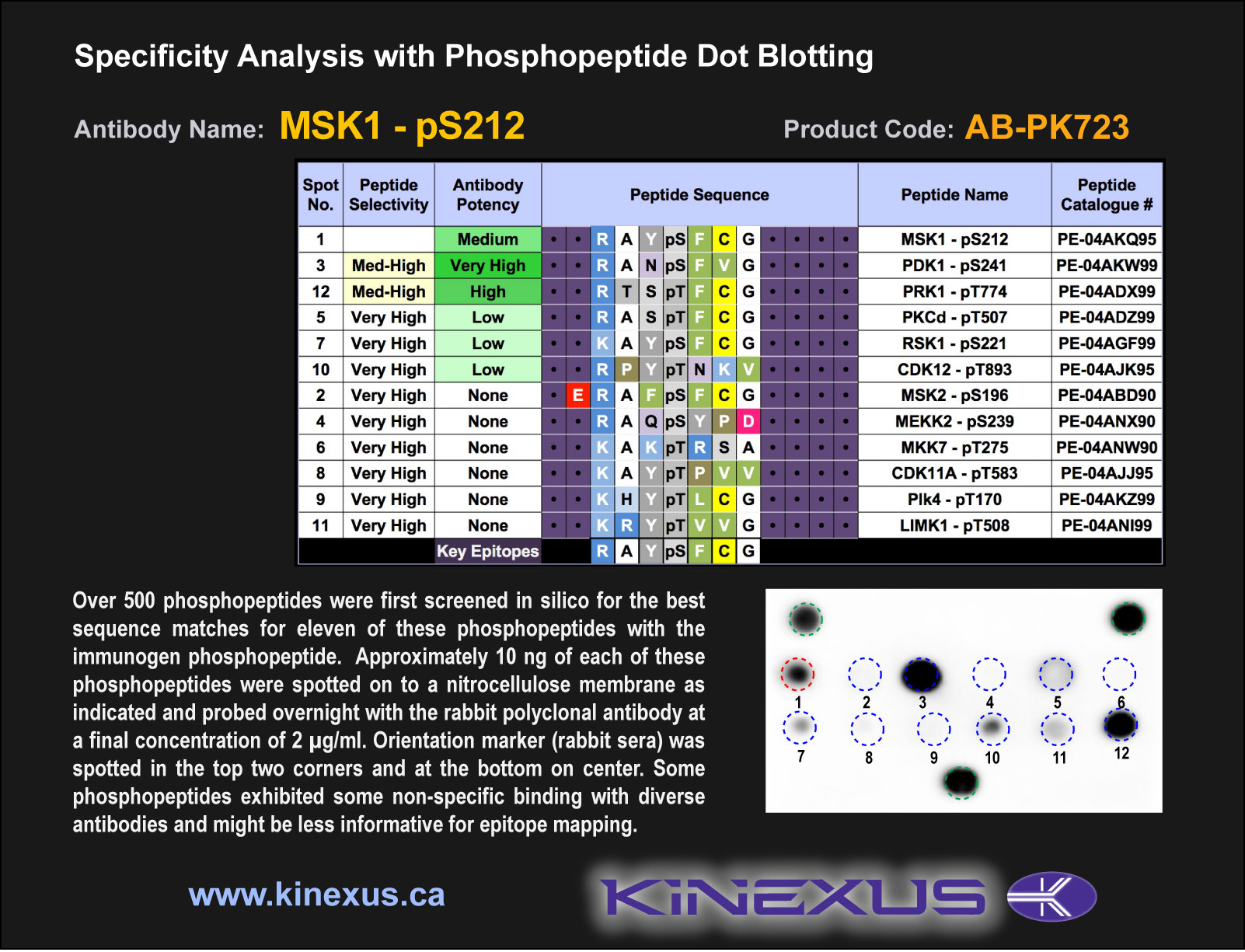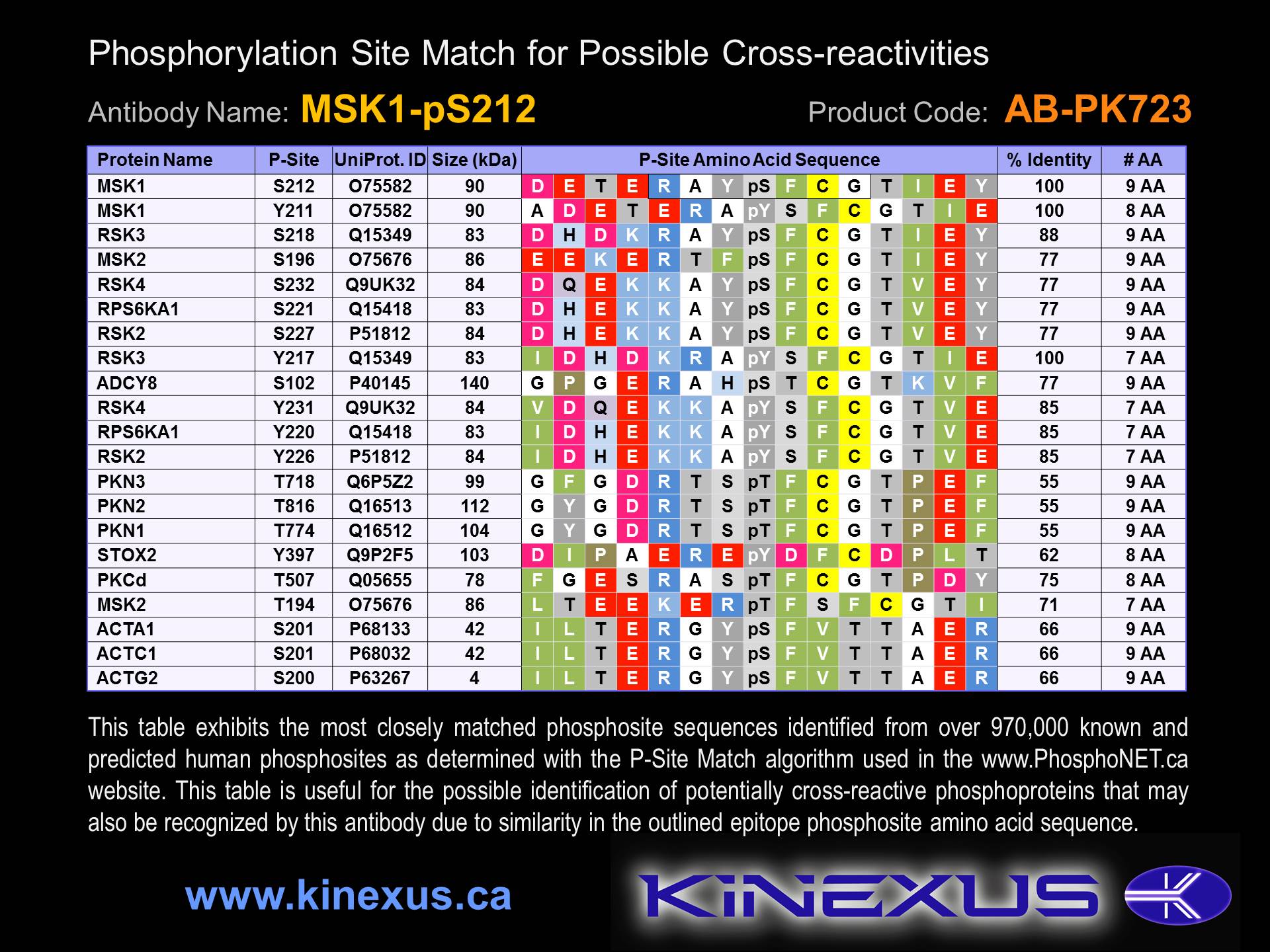Product Name: MSK1-pS212
Product Number: AB-PK723
| Size: | 25 µg | Price: | 89.00 | |
| $US |
Target Full Name: Mitogen & stress-activated protein-serine kinase 1; Ribosomal protein S6 kinase alpha 5
Target Alias: 90 kDa ribosomal protein S6 kinase, , polypeptide 5; 90 kDa ribosomal protein S6 kinase, KS6A5; Kinase MSK1; KS6A5; MGC1911; MSPK1; Nuclear mitogen- and stress-activated protein kinase-1; Polypeptide V; Ribosomal protein S6 kinase; RLPK; RPS6KA5; MGC1911; MSPK1; RLPK; CCDS9893.1; ENSG00000100784
Product Type Specific: Protein kinase phosphosite-specific antibody
Antibody Code: PK723
Antibody Target Type: Phosphosite-specific
Antibody Phosphosite: S212
Protein UniProt: O75582
Protein SigNET: O75582
Target Alias: 90 kDa ribosomal protein S6 kinase, , polypeptide 5; 90 kDa ribosomal protein S6 kinase, KS6A5; Kinase MSK1; KS6A5; MGC1911; MSPK1; Nuclear mitogen- and stress-activated protein kinase-1; Polypeptide V; Ribosomal protein S6 kinase; RLPK; RPS6KA5; MGC1911; MSPK1; RLPK; CCDS9893.1; ENSG00000100784
Product Type Specific: Protein kinase phosphosite-specific antibody
Antibody Code: PK723
Antibody Target Type: Phosphosite-specific
Antibody Phosphosite: S212
Protein UniProt: O75582
Protein SigNET: O75582
Antibody Type: Polyclonal
Antibody Host Species: Rabbit
Antibody Immunogen Source: Human MSK1 (RPS6KA5) sequence peptide Cat. No.: PE-04AKQ95
Antibody Immunogen Sequence: RAY(pS)FCG(bA)C
Antibody Immunogen Description: Corresponds to amino acid residues R209 to G215; In the protein kinase catalytic domain activation T loop region between subdomains VII and VIII.
Antibody Host Species: Rabbit
Antibody Immunogen Source: Human MSK1 (RPS6KA5) sequence peptide Cat. No.: PE-04AKQ95
Antibody Immunogen Sequence: RAY(pS)FCG(bA)C
Antibody Immunogen Description: Corresponds to amino acid residues R209 to G215; In the protein kinase catalytic domain activation T loop region between subdomains VII and VIII.
Production Method: The immunizing peptide was produced by solid phase synthesis on a multipep peptide synthesizer and purified by reverse-phase hplc chromatography. Purity was assessed by analytical hplc and the amino acid sequence confirmed by mass spectrometry analysis. This peptide was coupled to KLH prior to immunization into rabbits. New Zealand White rabbits were subcutaneously injected with KLH-coupled immunizing peptide every 4 weeks for 4 months. The sera from these animals was applied onto an agarose column to which the immunogen peptide was thio-linked. Antibody was eluted from the column with 0.1 M glycine, pH 2.5. Subsequently, the antibody solution was neutralized to pH 7.0 with saturated Tris.This antibody was also subject to negative purification over phosphotyrosine-agarose.
Antibody Modification: Unconjugated. Contact KInexus if you are interest in having the antibody biotinylated or coupled with fluorescent dyes.
Antibody Modification: Unconjugated. Contact KInexus if you are interest in having the antibody biotinylated or coupled with fluorescent dyes.
Antibody Concentration: 1 mg/ml
Storage Buffer: Phosphate buffered saline pH 7.4, 0.05% Thimerasol
Storage Conditions: For long term storage, keep frozen at -40°C or lower. Stock solution can be kept at +4°C for more than 3 months. Avoid repeated freeze-thaw cycles.
Product Use: Western blotting | Antibody microarray
Antibody Dilution Recommended: 2 µg/ml for immunoblotting
Antibody Potency: Medium immunoreactivity with immunogen peptide on dot blots.
Antibody Species Reactivity: Human
Antibody Positive Control: The observed molecular mass of the processed target protein on SDS-PAGE gels is reported to be around 90-95 kDa.
Storage Buffer: Phosphate buffered saline pH 7.4, 0.05% Thimerasol
Storage Conditions: For long term storage, keep frozen at -40°C or lower. Stock solution can be kept at +4°C for more than 3 months. Avoid repeated freeze-thaw cycles.
Product Use: Western blotting | Antibody microarray
Antibody Dilution Recommended: 2 µg/ml for immunoblotting
Antibody Potency: Medium immunoreactivity with immunogen peptide on dot blots.
Antibody Species Reactivity: Human
Antibody Positive Control: The observed molecular mass of the processed target protein on SDS-PAGE gels is reported to be around 90-95 kDa.
Antibody Specificity: Very high
Related Product 1: MSK1-pS212 blocking peptide
Related Product 2: MskSubtide - MSK1 (RPS6KA5) protein kinase substrate peptide
Related Product 1: MSK1-pS212 blocking peptide
Related Product 2: MskSubtide - MSK1 (RPS6KA5) protein kinase substrate peptide
Scientific Background: MSK1 (RPS6KA5) is a protein-serine/threonine kinase of the AGC group and RSK family. It is required for the mitogen (e.g. epidermal growth factor) or stress-induced (e.g. UV-C irradiation, anisomycin) phosphorylation of the transcription factors CREB1 and ATF1 and for the regulation of the transcription factors RELA, STAT3 and ETV1/ER81, and that contributes to gene activation by histone phosphorylation and functions in the regulation of inflammatory genes. It plays an essential role in the control of RELA transcriptional activity in response to TNF and upon glucocorticoid, associates in the cytoplasm with the glucocorticoid receptor NR3C1 and contributes to RELA inhibition and repression of inflammatory gene expression. In skeletal myoblasts, it is required for phosphorylation of RELA at S276 during oxidative stress. In erythropoietin-stimulated cells, it is necessary for the S727 phosphorylation of STAT3 and regulation of its transcriptional potential. It phosphorylates ETV1/ER81 at S191 and S216, and regulates its ability to stimulate transcription, which may be important during development and breast tumour formation. It directly represses transcription via phosphorylation of S1 of histone H2A. It phosphorylates S10 of histone H3 in response to mitogenics, stress stimuli and EGF, which results in the transcriptional activation of several immediate early genes, including proto-oncogenes c-fos/FOS and c-jun/JUN. It may also phosphorylate S28 of histone H3. It mediates the mitogen- and stress-induced phosphorylation of high mobility group protein 1 (HMGN1/HMG14). In lipopolysaccharide-stimulated primary macrophages, it acts downstream of the Toll-like receptor TLR4 to limit the production of pro-inflammatory cytokines. MSK1 is activated by phosphorylation at S212, S360, S376, T581 and T700. PMA or UV-C induced kinase phosphotransferase activity can be reduced 60% with a S360A mutation, plus a T700A/D can lead to decreased phosphorylation of T581. Kinase phosphotransferase activity can also be lost either with a S376A mutation, leading to decreased phosphorylation of the S60 and T581 residues, or with a T581A mutation leading to decreased phosphorylation of S212, S376, or S381. Aberrant activation of members of the MSK1 family have found to be linked with many human diseases, such as breast and prostate cancers.
Figure 1. Epitope mapping of MSK1-pS212 antibody with similar phosphopeptides on dot blots.
Figure 2. Identification of phosphosites related to MSK1-pS212.
© Kinexus Bioinformatics Corporation 2017



